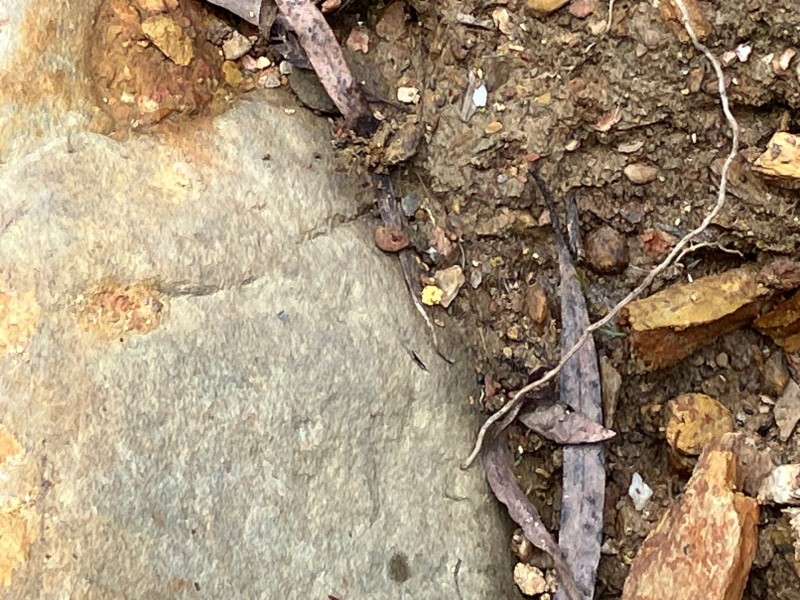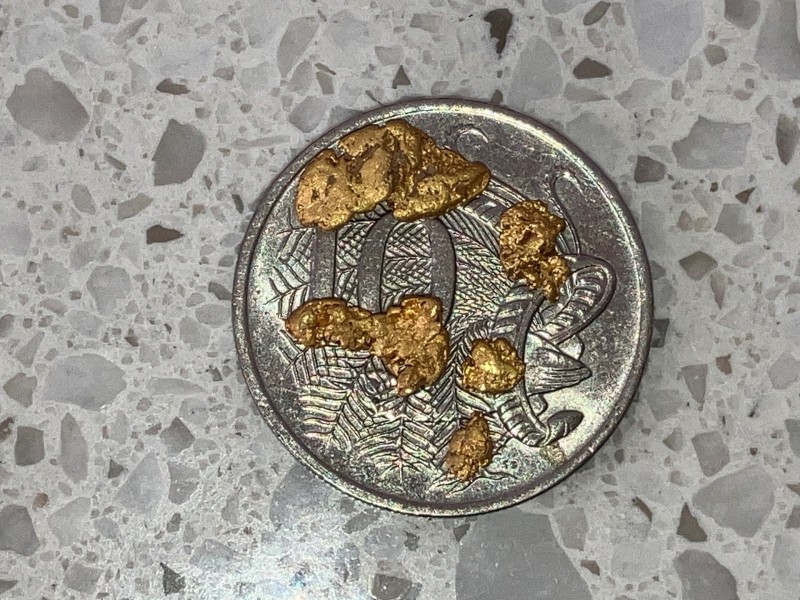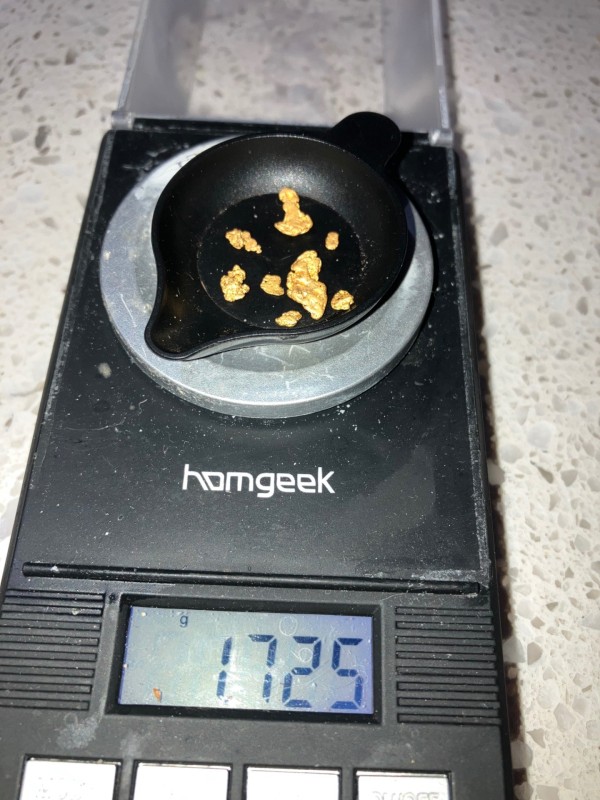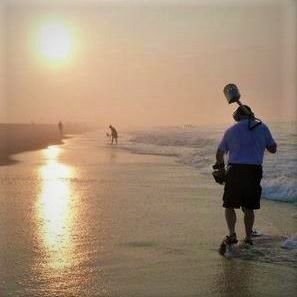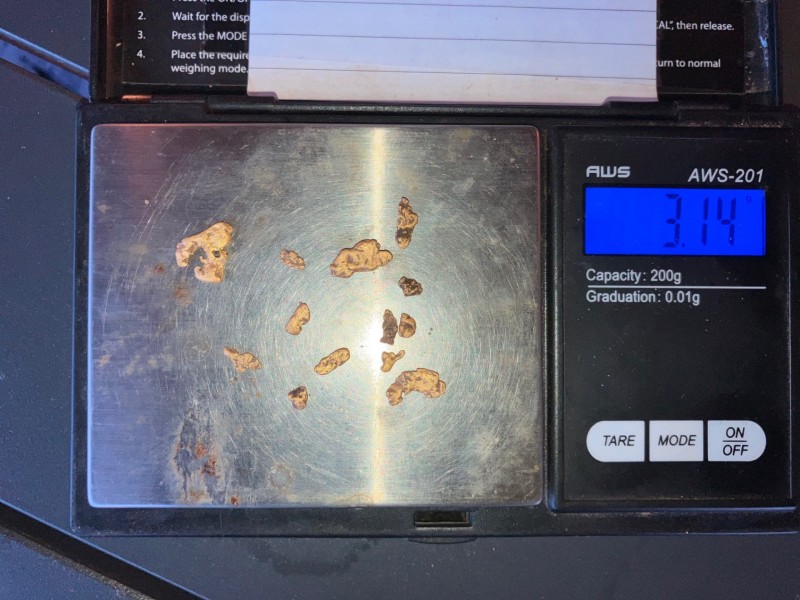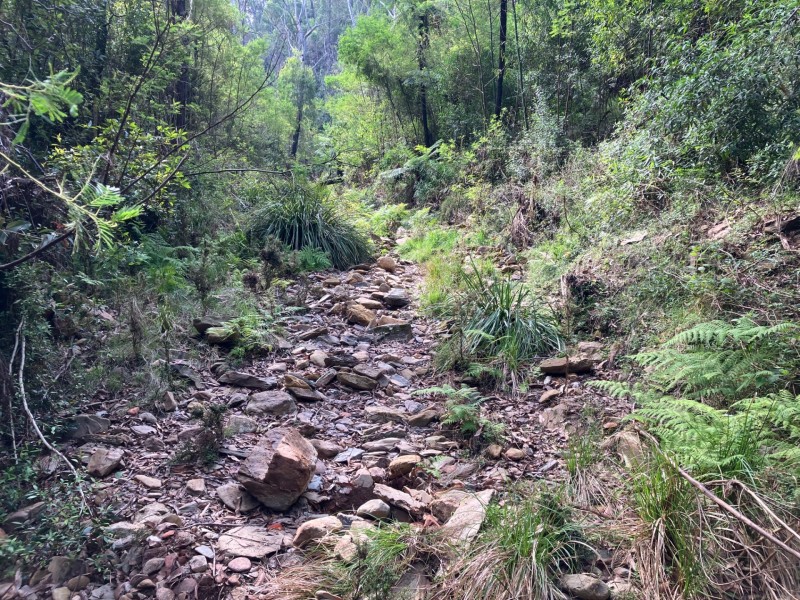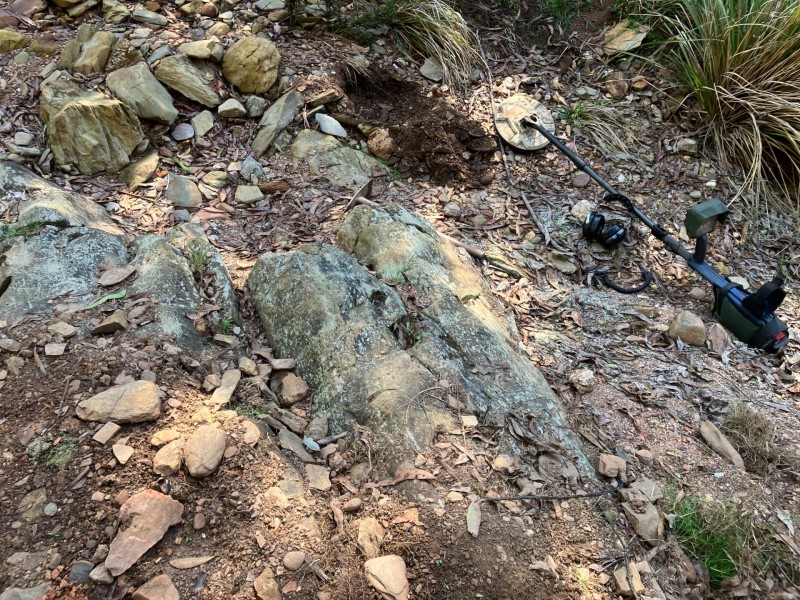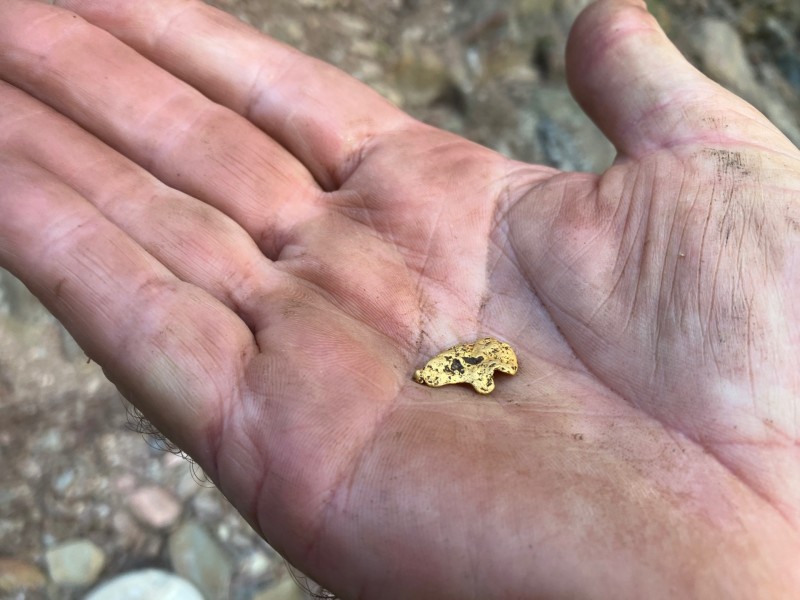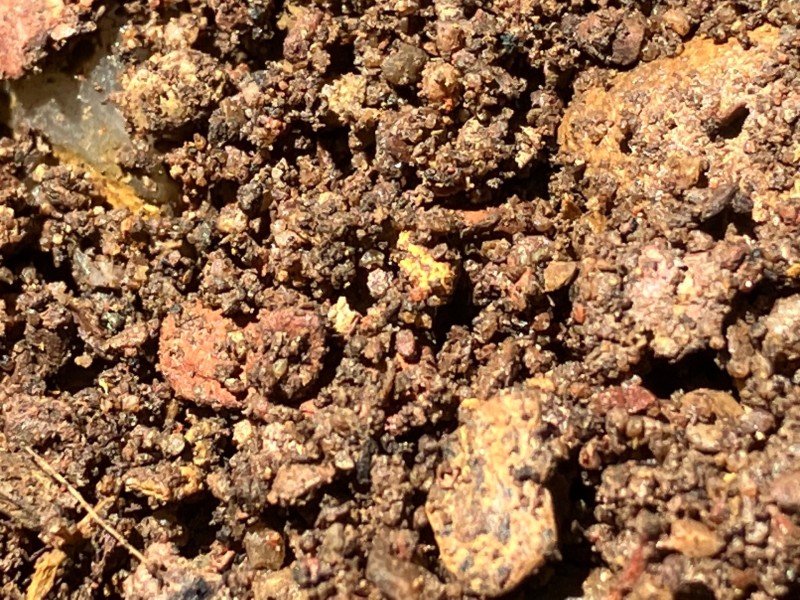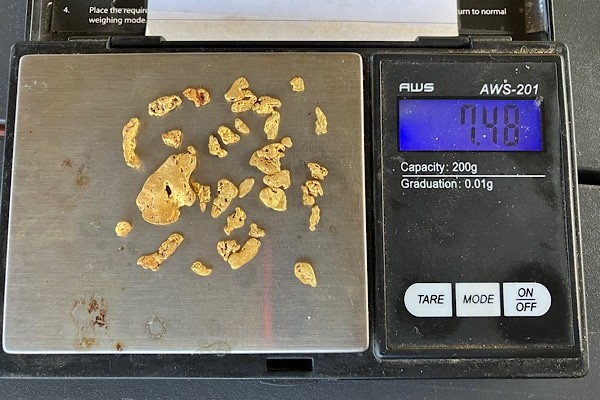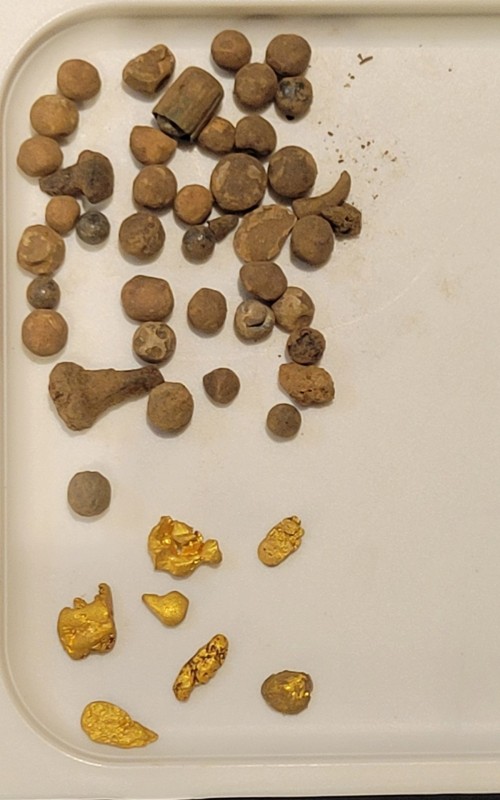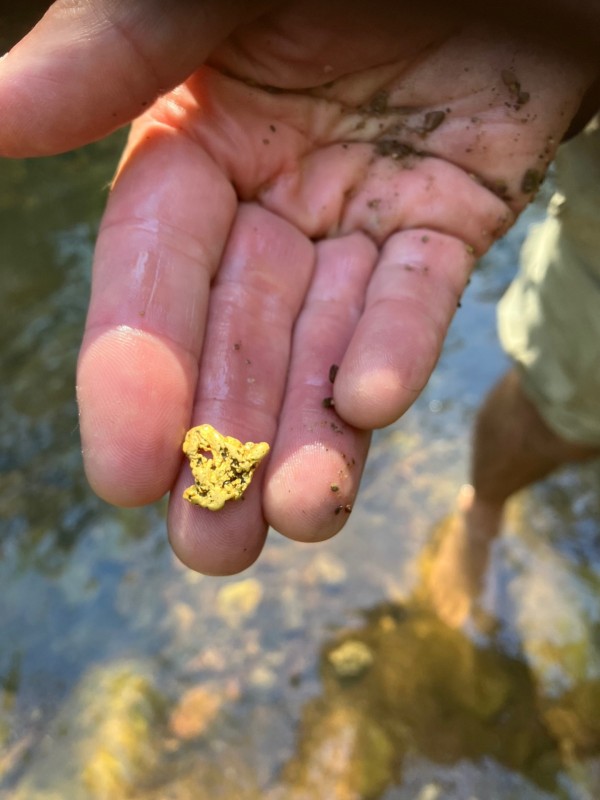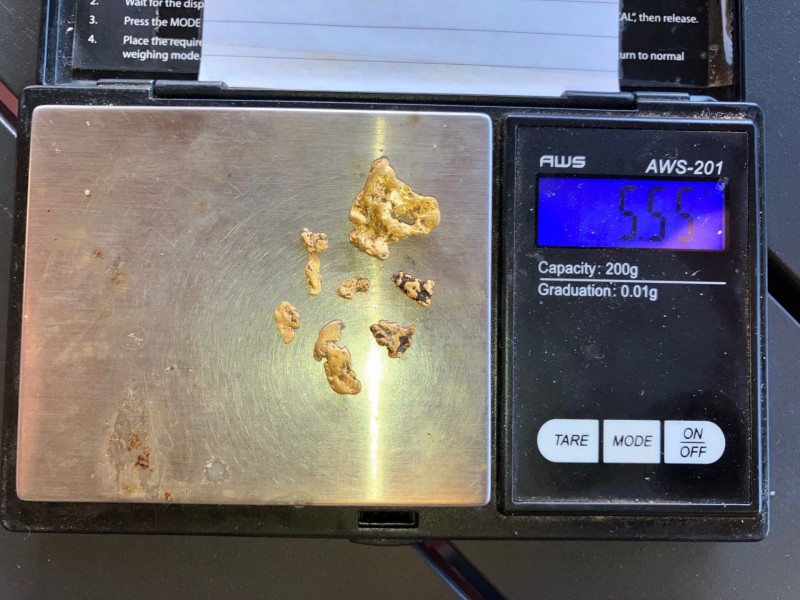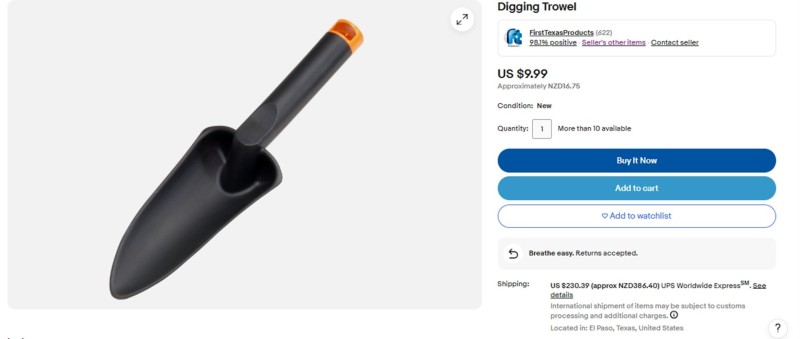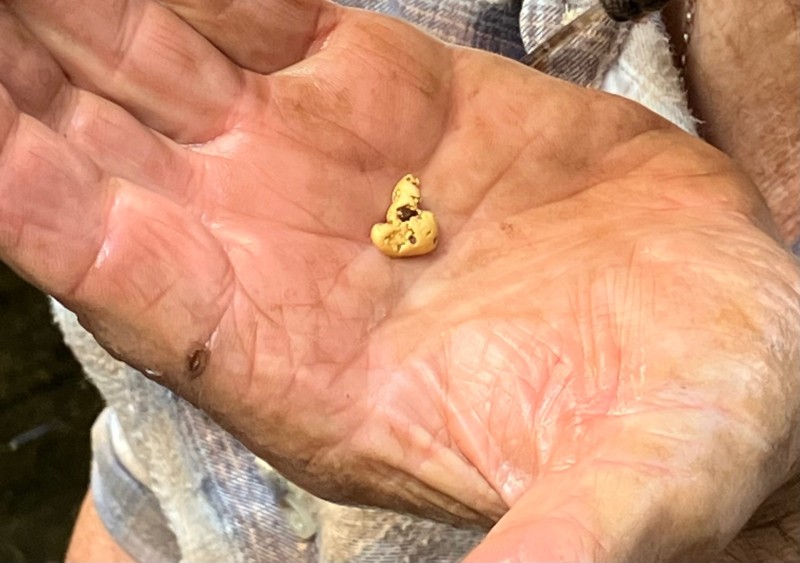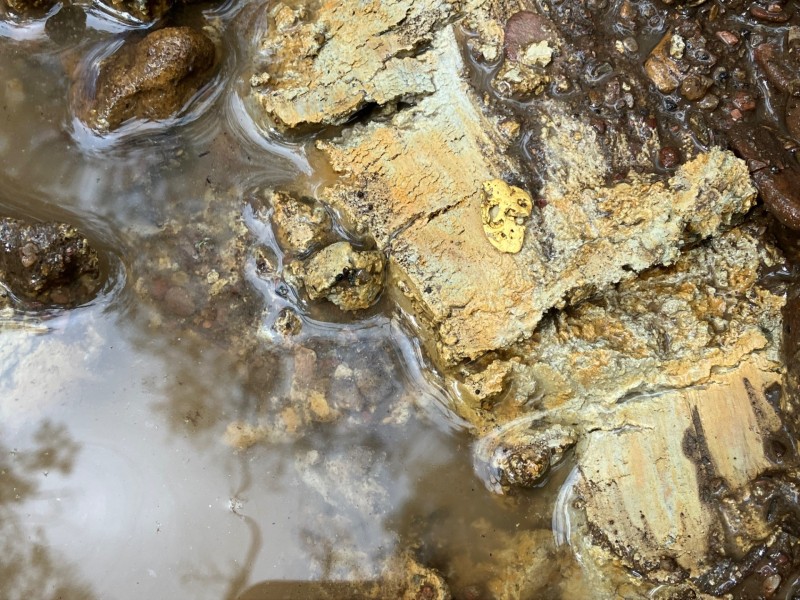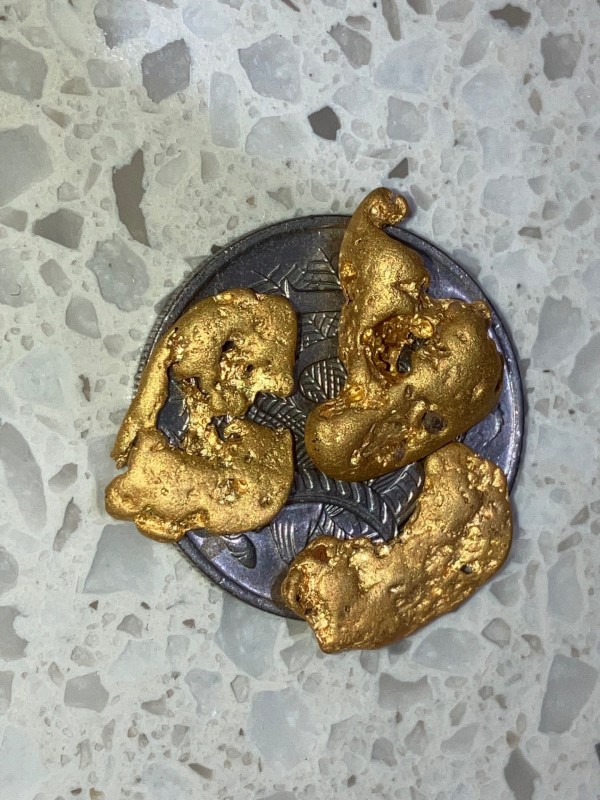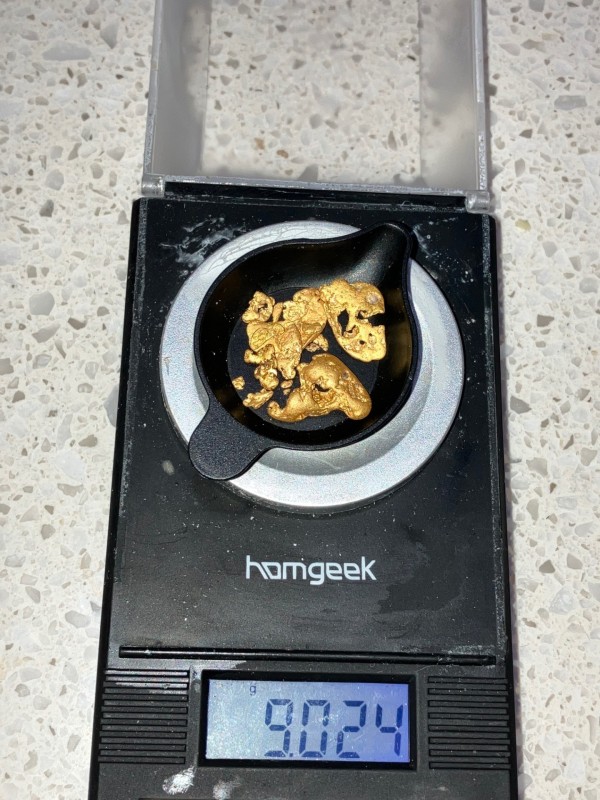Search the Community
Showing results for '“Sand scoop”'.
-
Ms3 Z-Lynk Kit Opinions Pro & Con
Knomad replied to Lead Detector's topic in Metal Detector Advice & Comparisons
I don't know if the kit is the same, but the MS3 system that comes with the Axiom is JUNK. It is so weak and directional that it drops out if you set the detector down next to you to run a scoop over the coil.! Or if a large bug gets between the detector and the headphones it seems. Don't even think about any Proprietary Systems like these that require you use ONLY Their headphones, you can buy a Low Latency Bluetooth Transmitter much cheaper on Amazon, then use ANY low latency Bluetooth headphones or any other low latency devise you want. -
September 29 2002 Part One Nearing Bedrock The weather today is hot and dry. This morning we started digging deeper into the pit and followed the sloping walls of granite down. The dimensions of the pit are narrowing quite a bit now and Jacob believes we are nearing the bedrock. The crew is watching as the excavator takes away each scoop. No one is saying a word but you can feel the excitement in the air. The gravels are being stockpiled as per our plan in order to ensure we will have a water supply to run the bottom gravels first. I have been test panning and the gold seems to be getting coarser than before. We must be close. TO BE CONTINUED ................
-
Hi Folks, Just thought I’d give a bit of feedback on the 8” X Coil that I pinned to the 7000. Yesterday was its maiden voyage into our local gold country and Joe and I were keen to see how it performed in the field. We decided to go back to a creek bed that was mainly dry to see if we could scratch out a few targets and do some comparison work between this coil and the 10x5 Coiltek that was swinging on the end of Joes 6000. After burying a few targets the day before and running both machines over them, we already had a bit of an idea as to how it would perform but nothing beats detecting in a real situation to see how a machine/ coil combination works. I purchased this coil so that I could give my daughter the 6000 when she comes out detecting and I could then use the zed with a small coil to work through old workings or around rock bars. The 12” ZSearch is a great coil but is a bit too large for this type of work (especially with the thick undergrowth that now exists in our gold fields.) The first thing I noticed was the weight of the coil. It is reasonably heavy for its size. It is of a similar weight to the 12” coil and I’m guessing it is full to the brim with wire. On the Zed it is well balanced and it swings nicely with minimal effort. External build quality looks quite good and it appears that it should be able to cope with a good workout. Joe and I decided to walk the gully well past where we detected on the last trip and see if there was any gold present higher upstream. The first issue with the X Coil is that it’s not waterproof so I was restricted to dry rock bars and banks. Joe was able to do the shallow pools and submerged bars to ensure that we had all bases covered. The area where we started to detect was highly mineralised with hot rocks and noisy ground upsetting both machines. Threshold was stable but false signals due to the ground were an issue until we moved downstream. Apart from a couple of bits of rubbish, nothing of any real interest turned up. We slowly worked our way down stream until we got to an area that had produced some gold on a previous trip. The zed was behaving a bit like a hyperactive kid that had been fed a handful of red lollies. In other words, it was running like a 6000. In a funny, twisted sort of way, it was a good feeling as I knew the coil was right on the edge and was super sensitive. As we had detected this area before, we knew that we had to make a bigger effort to reach difficult spots, move a few rocks and fallen vegetation etc to see if we could uncover something of interest. Joe started detecting a yellow clay bank as it was a good trap for gold during a flood. I decided to try an steep area that was well above the stream bed where there was evidence of past working by the old timers. At the base of a cliff face, I noticed a couple of undercut areas which were gouged out by last years floods. I was able to get my detector coil into one of these holes by lying flat on the ground and reaching forward through some flood debris in order to swing the detector. A very faint moan hit the headphones which wasn’t surprising at all as the hole had a lot of red mineralised soil in the cavity. It sounded just like every other broad, false signal that I’d been getting during the morning from similar material but as per usual, a check was in order. The pick was used to drag out about 6” of this dirt. It was soft and not compacted in any way which indicated it was recently deposited. When the detector was placed back into the hole, the signal had sharpened up and I knew that I had something metallic. I wish now that I’d called Joe over before any material was moved so that we could have done a bit of a comparison between the machines. My gut feeling is that the 6 would not have heard anything at all but we will never know for sure. Eventually I dragged out a nice little nugget of about 3/4 gram. When I ran the machine over the spoils, a signal was detected and another small piece was recovered. Joe picked up a couple of small pieces that were barely a signal so he didn’t call me over to check. You know the ones I’m talking about. “Is that a signal?” One small scratch with the pick and then it screams at you. The typical 6000 small gold scenario. I started detecting a high vertical bank that had washed away badly last year. When I placed the coil under a tree root, the machine screamed loudly in protest. I knew it had to be junk or a shallow piece of gold. One careful scrape with the pick and it fell into the scoop. Couldn’t believe my luck when a nice little half grammer winked at me. No skill in that one. A kids detector could have found it. But in saying that, no one had put a coil in that location before so I took it with a smile. After a brief stop for lunch, we continued to slowly move towards our starting point. I picked up the zed and took one step forward before getting a nice little double “bleep”. It was pointless getting the 6000 to run over that target as it was quite a shallow, dig me signal. Turned out to be a 0.08g piece at a depth of about 1.5”. It was good to see that the coil could pick up bits of fluff with ease. I decided to follow Joe and work the same clay bank that he had just detected to see if there was a deeper target to find. Normally, that wouldn’t be a good idea as Joe is very good on the detector and rarely leaves even a scrap for his mate. About 3 metres from where I picked up the little nugget, I ran the X Coil over some vegetation that had been partially washed away by flood water. I could see the clay bank was about 5 inches under the exposed roots of a small bush. To my surprise, I picked up a signal when the coil passed over the area. The vegetation was pulled out of the way and this is what I saw: Before it was moved, I called Joe over for a look. It was a beautiful little sunbaker. Joe passed his coil over the top of the nugget and lost the signal at about 4”. The process was repeated with the X Coil. It still gave a faint signal at about 5.5”. That was the first bit of information that demonstrated some of the X Coils potential. The piece weighed in at 0.095 grams which is pretty small. Joe picked up a couple of micro bits on a bank during our walk towards the car. He finally found a slight but repeatable signal that he thought might be a good test for the new coil. He put back the scrape of material that the pick had removed and the X Coil was then directed across the area. In all honesty, there was very little evidence of a signal at all. There may have been something but under normal detecting conditions, it would not have stopped me. When the scrape material was removed, a faint signal was heard. It ended up being a really small piece of shot and showed how good the 10x5 coil attached to the 6000 is when the gold size gets really small. It was a day that was hard work and didn’t prove anything much at all except that the X Coil is capable of finding small gold at good depth. Will it compete with the 6000? In some situations depending on gold size and depth, it may do well. In others where the gold is really small and shallow, the situation may be different. From yesterdays trip I could say with confidence that the zed/ X Coil combination is one that I will use in many of our future adventures. Will try updating comparisons as we test over time. Here is a pic of the gold that it found on its first outing. And our tally for the day.
- 2 replies
-
- 14
-

-

-
- minelab gpz 7000
- gold found
-
(and 1 more)
Tagged with:
-
The F19 VLF I just got would have found that piece with ease and I say so in the initial post, it was nothing to do with the detector, as if often the case, just like when I found a couple of bits with the Algoforce in the same area a few weeks earlier, nothing to do with the detector, just the coil being in the right place. The 6000 likely would have found most if not all the gold I found in the thyme bushes, ,they're both very good detectors, and on this sort of gold they're very competitive with each other although I do still favour the 8" on the GPZ over the Coiltek 10x5" on the GPX 6000 on this small gold as if golds a bit deeper I have more confidence the GPZ will find it and the 6000 may not (small coil vs small coil), I might be wrong and don't have enough experience finding thousands of bits of gold but I find the GPZ tends to find deeper bits than the 6000. I'm not so sure the 6000 would have found all the gold the 15" CC found on that patch, but it likely would have found some bits the 15" CC missed. If I ever find another patch similar, I'd use both detectors on it with a few different coils for the best results and that's why for now at least I'll keep the 6000 even though it's not my favourite detector. What I did notice that day was the Equinox I had with me would have missed a lot of the gold I was finding with the 8", and of course the 15" CC I was able to do a lot of side-by-side testing that day between them, and in the video I demonstrate the Equinox not picking up one of the bits until much closer to it so that day helped move me off wanting to use VLF's so much as prior I was a big fan of using the VLF's and often used one instead of my GPZ much to JW's surprise, he never did understand me rocking up with my Nox instead of my GPZ 🙂 Looked at me in shock horror sometimes when I appeared with a VLF. 😀 Something else that is fact, I'd missed that 4.1 gram bit I showed the recovery video of with the 8" on the GPZ with other combinations, , it's a slim little bit of soil between two dug out areas. yet the 8" got it, even though it was quite deep, deeper than my scoop.
- 41 replies
-
- minelab gpz 7000
- minelab sdc 2300
-
(and 1 more)
Tagged with:
-
Does anyone know who makes the Extreme Scoop handles and would you know the weight of the 46" handle? Thanks, El
-
I had an interesting experience this past summer. I was hunting virgin bedrock in a placer cut/pit. There were some nice nugget finds, and then I started to work a bedrock rise with a vertical edge that dropped about three feet into a larger sheet of bedrock. Piled up against that edge about six inches high was channel material the large bucket on the excavator couldn't scrape out. (Sometimes these spots hide nice nuggets too.) I took my pick and worked some material off the top of the dirt and scanned the bottom dirt with the Goldmonster. I got a signal and watched the display. The bar jumped to the right, then headed back into ferrous territory. With each sweep, it read the same way. I isolated the signal, and it was a flake of gold, about half the size of an oatmeal flake. I was surprised the display hadn't pinned all the way to the right in non-ferrous territory. I kept scraping away top material to detect the ground below. The same thing happened again, the signal ID'd off to the right then back to the left. Another flake of gold, about the same size. I looked closer at the material I'd dumped from my scoop, lots of little bits of magnetite and dark, heavily stained rocks. I worked more material in the same way, and I kept getting flakes with every scrape all the way down to where the jutting piece of bedrock met the bedrock sheet. There were a few larger pieces that pinned all the way to the right, but all the others, a nice catch of flakes, did the iffy bounce. With the Monster it really pays to check out those iffy signals or I'd have left a nice whack of flakes in the ground. All the best, Lanny
-
Good afternoon to my fellow detectorists I'm looking for any recommendations for sand scoops for the beach, wet and dry sand. I'm currently using a 41 inch stainless steel scoop that's durable but it gets to be fairly heavy after a few hours. I was looking at the Extreme sand scoops but the titanium is way more that I want to spend right now. Any suggestions would be appreciated
-

Who Uses A Pinpointer On The Beach?
MD4V.org replied to Bill (S. CA)'s topic in Metal Detecting For Jewelry
I think if you are a sugar-sand hunter there is no need for a pinpointer. I hunt Atlantic beaches in New York, and Sound beaches Connecticut. A lot of Sound beaches are rock or shell infested, but a good scoop - and the hours on it to become proficient, rules out the need for a pinpointer even on those beaches. If you are primarily a dirt hunter I can see using a pinpointer in dry beach sand - habit. -
Just curious how many of you use pinpointers on the beach. I've been a beach hunter for over 40 years and have never used one on the beach. But nowadays I see a lot of hunters using them to pinpoint coins which I think is pretty silly. I can find any coin with my sand scoop no problem. I get it if you are hunting for micro gold on the dry but otherwise to me it's unnecessary. What do you folks think? Bill
-

Using The 7000 To Pick Up The Scraps Missed By The 6000
Lesgold replied to Lesgold's topic in Detector Prospector Forum
There’s an old saying that goes something like this - “never walk away from gold to look for gold.” We knew that the detectable yellow in this spot was starting to hide itself away from us and the only thing that we could do was to work harder and try to change our approach. Joe and I decided to mix things up a bit during yesterdays playtime. We agreed that instead of both of us using the one type of detector, we would take one zed and one six. Joe had the 7000 with the 12” Nuggetfinder and I took the 6000 with the 12x7 attached. We also decided to wear waders so that we could focus on detecting the deeper pools and also protect ourselves from leeches. It was a beautiful, cool day which kept us comfortable while we were wrapped up in plastic. Joe still had problems with the zed giving false signals in the deeper water but he eventually solved the problem. We had thought that the issue was due to the pressure of the water compressing the coil and making it touch sensitive but we were wrong with our assumption. The actual cause was the slight flexing of the shaft due to the forces involved in keeping the coil submerged. Joe found that if he placed his left hand quite low on detector shaft and guided the machine with his hand, the problem disappeared. Repositioning the guide arm much lower than usual could be worth trying if we continue to detect in water. We started working our way up the gully after finding a couple of small pieces of flood gold on the bank of the creek. We had to stand in water to detect this area which made it obvious as to why they were still there. I made it to a pool that had produced some nice gold on previous trips and decided to detect it really well. Having waders on allowed us to take our time to cover areas well without having to worry about getting wet. The six ran reasonably well most of the time but wasn’t as stable as the seven. The mineralised black or red soil in any wet area would upset it but it generally ran well. The Nuggetfinder coil did its job and picked up a target in about knee deep water. Joe and I had to fluff around for about 5 minutes before a nice little piece ended up in the scoop. We moved up to another patch that had produced a lot of small pieces a few weeks ago. On our last trip we were not able to go over this area as it was still submerged. Joe picked up a good signal where rock and gravel had moved with the recent rain. It was an unusual signal that had a distinct wobble to it. As usual, we always try to analyse what we are hearing and have a guess at what the result would be. We decided that it would be gold and that it would have an unusual shape. A long, C shaped piece quickly ended up in Joe’s hand. A few more small pieces were recovered from this area after moving some rocks and gravel. We continued to detect our way upstream without finding anything but rubbish until Joe ended up with a beautiful low/high signal in a long pool of water. He called me over to have a listen and as we often do, both machines were put over the target before the surface was disturbed. Both detectors picked up the signal well with the seven giving a better response. As it was in water, the dig was a bit slow but after a few minutes the best piece of the day was in the rattle jar. A few more small nuggets were found upstream before we decided that the day was done. It was another good, productive trip out in the bush. We still have at least one more day to finish this area before moving on to a new spot. -
My detecting mate and I have been working a dry gully for quite a while using our 6000’s with 10x5 Coiltek coils attached. We had been finding a bit of small gold but lately our returns diminished and we had almost decided to move to a new location. In a bid to squeeze out a few more pieces, we decided to detect the ground with our 7000’s and try to uncover a few deeper nuggets. We weren’t expecting much as we had spent a considerable amount of time working this area on the short gully and thought that if we could come home with a piece or two we would have achieved our goal. The Six with the small coil really suited this area as there were many potential gold traps and hiding spots for the tiny pieces that inhabited this location. The Zed’s were fitted with Nuggetfinder 12” Z search coils and after a ground balance and tune were running exceptionally well. The hot rocks and noisy ground that played havoc at times with the 6, were ignored by the 7’s so we knew that we had a bit of potential to find that really subtle signal. We moved slowly and tried to get into difficult areas and hopefully jag something for our effort. After about 20 minutes we added a couple of small pieces to the rattle jar from steep banks on the sides of the gully. It was agreed that the shallow pieces would have been picked up easily with the 6000 but were now happy that we hadn’t been “skunked” for the day. Joe was working a stretch of ground that had produced well for us in the past so I decided to move upstream about 50m to give him some space. I started at a rock bar that had given up some treasure about a month or so ago. We had pulled about 6 very small pieces on and around the outcrop and made a concerted effort to cover all the ground in that area very well. Every subsequent trip resulted in a repeat of that process just in case we missed something. The same region was detected today with the Zed and to my surprise, a very faint signal was heard. It was in an ideal location next to the rock bar on the inside section of a bend. You can see the hole in the photo. We had hoped to find a piece of gold at a depth that the Six couldn’t see and it finally happened. It must have been on edge as the signal was initially very soft and only increased during the dig. What popped out was a pleasant surprise. The 6000 has dominated our detecting for a couple of years now and the Zed barely gets pulled out of the cupboard. It was good to get its coil scraping on the ground again and put through its paces. We had forgotten how quiet it could be when the ground suited. We had also forgotten about digging deep holes until we were quickly reminded of its power. Rusty nails and bits of steel with soft enticing signals generally resulted in ugly growls and swimming pools being dug half way to China. We moved upstream and continued to detect some old ground looking for that deeper target. I was lucky enough to get a really faint signal behind a large rock. After digging a deep hole, a small, shiny nugget surfaced. I could see why the Six would not see a piece of gold at that depth. When the hole was inspected with the coil, another break in the threshold told the story of a surprise awaiting inspection. When a piece of gold ended up in the scoop, I called Joe over and we started moving rocks and detecting a small area thoroughly. A bunch of small pieces resulted. We had a lot of fun working that area together. Joe finally moved 20 metres upstream and found another patch of deep, small pieces of gold. The river worn gold was often visible in the scoop or in the ground like the piece shown in the picture. Joe pulled a couple of pieces on the walk back including one that was in a pool of water. Boots and socks came off and a slow and frustrating recovery followed. It’s great to see a prize for all the effort put in. The final picture shows the result of our day out. Quite a few of the pieces were so small that they wouldn’t move the scales but they all added up. It is pleasing that the Zed can still earn its keep on the tiny gold. Most of the pieces found would still be in the ground if we had used the 6000’s on this trip. Having a combination of machines has proved to be a winner in this area.
-
Who Uses A Pinpointer On The Beach?
rvpopeye replied to Bill (S. CA)'s topic in Metal Detecting For Jewelry
Unlikely to use mine in the water. Just scoop as fast as possible before it fills back in.😏 In less wet to dry sand , I use mine almost every target to zero in better after using coil PP , mostly to keep from trashing the target . I'm no stranger to a scratched or destroyed target that just got a kiss by my dig tool . When I find that first gold ring , it must be PERFECT ! 🤩 I still use the coil to PP but even with the 6" I was still finding a target that had jumped to the side wall once I got the hole opened up and then up and up. It's not so much a time thing but wear and tear on my elbows. Five seconds of handheld PP vs one or two extra scoops ... and besides , as we all know smaller holes are better 😜 -

Who Uses A Pinpointer On The Beach?
Joe D. replied to Bill (S. CA)'s topic in Metal Detecting For Jewelry
Also use mine all the time on the beach, and everywhere else! Reduces my target location time, and helps me not to damage my finds by digging too close! Pinpointing with the coil is a great skill to have, but not always as practical or as speedy, depending on conditions, and obstacles! And just to add to what you said, i use my scoop in another way at the beach probably 90% of the time, besides sifting dry sand, or sifting in the water! I scoop, and kick the sand out on the beach, sweep a foot to spread, and if the target is not visible, than i pinpoint! It all happens very quickly, so I can move on searching! Also save's my arm from lifting up to sift repeatedly! It's nothing unique, as I've seen many do the same! 🍀👍👍 PS, If you get one, always have it on a bungee, or it will inevitably belong to someone else! Saved mine on numerous occasions!👍 -
Well all my squat exercises came in handy after getting up and down to recover all this bird shot in the Vic. Goldfield this week. I can tell you that the E1500 loves the stuff and will definitely hear the tiny ones missed by others. My first gold with the Algo was a welcome sight in the scoop all the same...😃
-

Using The 7000 To Pick Up The Scraps Missed By The 6000
Lesgold replied to Lesgold's topic in Detector Prospector Forum
We ended up with some good rain last week and some minor flooding resulted. Joe and I were keen to get back to the gully with the hope that the rocks and gravel would have moved around and hopefully provide some new opportunities. When we arrived, it was obvious that the changes were only minimal but there were areas where some erosion had taken place or deposition of material had occurred. We decided to use the Zeds as they would be much quieter in the wet conditions. The six can be a real pain when the mineralised soil becomes damp and can, at times, be unusable. The Zed also suffers from the same disease but not to the same extent and can mostly be tamed. When we arrived we noticed that water was still flowing which restricted our movement. We thought this would be the case and knew that we would only be able to work the shallows and edges without filling our boots. Joe picked up a piece fairly quickly and got the monkey off his back. We have always said that once we have a piece of gold each, the rest of the day is a bonus and we don’t go home skunked. Don’t get me wrong, we still have enjoyable days where the rattle jar just doesn’t rattle but having a piece of gold in your hand puts the icing on the cake. After moving upstream, I decided to inspect the pool where a good nugget was found on a previous trip. The water level was obviously higher than a couple of weeks ago but there was evidence of erosion on the steep edge below the water surface. After a couple minutes a good signal was detected and Joe came up to help get the target out. This meant removing snake gaiters, boots and socks and then rolling pant legs up above the knees in preparation for the extraction. I noticed a leech had attached itself to my leg and had begun to draw blood. He was quickly dispatched and I climbed into the water to dig the target while Joe guided me with the detector. After a couple of minutes a nice little nugget was recovered in the scoop. Joe suggested that I should check the remainder of this pool while I had my boots off. I continued detecting and thought I had a target in a deeper area of the pool but it turned out to be a false signal. We both found that the Z Search coil would false in water once it was submerged over about 12”. Perhaps it’s the pressure compressing the top and bottom faces that makes it a bit more bump sensitive. This combined with the mineralised material was probably contributing to the issue. After slowly detecting most of the pool, a broad, faint signal was picked up. I dug down about 8” and by this stage, the zed was getting pretty excited. It was already quite difficult as I was in about a foot of water and every dig saw the pick head and much of the handle totally disappear below the surface. Digging continued until the target finally moved location slightly. The scoop was then used to recover what turned out to be a nice piece of gold. With no other signals found, it was time to get out of the water, kit up and move on. Two more leeches had found me while I was walking in the water and needed to be encouraged to find another food source. That was my final contribution for the day. Joe found some more pieces near a patch that we had worked recently and made the tally look a little more respectable. The final drama occurred late in the day. I had been walking through some thick scrub and somehow dropped my radio. I didn’t notice it until much later and thought it was lost forever. It must have got caught in some bushes while I was pushing through the dense undergrowth and snapped the catch causing the radio to drop. Joe and I retraced the path and used his radio to call up the lost unit. We eventually heard the other radio and were able to follow the sound until it was recovered. That was the signal to call it quits for the day. We didn’t end up with a huge number of pieces but we were happy with what we had found. We may visit this spot again when the water level drops. -
Who Uses A Pinpointer On The Beach?
schoolofhardNox replied to Bill (S. CA)'s topic in Metal Detecting For Jewelry
I use mine all the time. The areas I dig are rock packed, clay, shells. I can't use a scoop in that area. Most of the time I also use a screwdriver to pry small rocks apart and get between big rocks that do not move. Even in the wet sand, there are rocks that make it very hard to use a scoop, in addition to the hole filling up with water. It helps locate the target so I don't end up digging the forever widening hole 😄 -
.thumb.jpg.8761b3d9b3da119b9e6d1912f67275ad.jpg)
Who Uses A Pinpointer On The Beach?
F350Platinum replied to Bill (S. CA)'s topic in Metal Detecting For Jewelry
Sometimes the sand just won't sift through the scoop, so I try to keep one with me, and regret it when I forget it. It's all about target retrieval time for me. -
September 17 2002 The weather today was bright and sunny and temperatures were in the low 80’s. The rains are long gone now and the creek has come down some. Yesterday Conor and I worked until nearly dark on the haul road while Clay and Jacob did some maintenance on Old Bulldog. We were able to get the washed out areas repaired so Clay could get his truck about halfway up the old mountain road. We dumped rock in the bottom of the bad areas and then we were able to scoop loose gravels from the side of the road into the washed out places. I mixed in some coarse tailings with the gravels and the repaired areas are good enough to drive a car over. Clay got his Mack over the bridge and close to the processing area. I loaded him up with tailings and he proceeded up the mountain in reverse. Conor followed him with the skid steer. There was no room on the haul road to turn a truck around and until we got the last part of the road repaired Clay had to drive up there backwards. There was just room enough to get the skid steer out of his way so that he could drive back down the mountain. It’s not an easy task going up there in reverse as the turns are tight with a few bad drop offs but Clay was more than up to the job. We had the old mountain road completely repaired by dusk so tomorrow we will begin hauling pay gravel and running the tom. There is nothing to stop us now. TO BE CONTINUED .............
-
New AQ Ltd $1300
phrunt replied to The_Stalker's topic in First Texas - Bounty Hunter, Fisher & Teknetics
Not at all tempted on an AQ, a final version, maybe, the AQ Gold, likely. I'd never spend my money on a beta product with no warranty essentially due to geographical location. Unlikely shipping it back for repair would be viable WHEN it breaks down. In saying that, maybe they've seen me poking fun at their shipping prices, suddenly they've removed Worldwide shipping off their listings and they now just Say USA, Mexico and Canada as shipping options and to contact them if elsewhere for a quote. They too probably thought over $200 USD to ship their garden scoop was excessive. -- Update: They've changed it on the AQ to only those countries, the other detector listings have remained the same with crazy shipping so the garden scoop is still $230 USD to ship 😛 -
All Roads Lead To First Texas
phrunt replied to Steve Herschbach's topic in First Texas - Bounty Hunter, Fisher & Teknetics
It just keeps getting better! This is actually quite funny $9,99 for their garden scoop, only $230 USD to ship it 😛 It must fly first class with all the trimmings, via the moon. -

Using The 7000 To Pick Up The Scraps Missed By The 6000
Lesgold replied to Lesgold's topic in Detector Prospector Forum
Yesterdays largest nugget was a bit of a strange find. I watched and partially helped Joe dig two really deep holes for junk. He was exhausted and frustrated that neither target ended up being the right colour. It was just one of those days where his junk to gold ratio was higher than mine. My turn will come next trip. I moved a bit further upstream and started detecting the bottom of a long pool of water. Everything about it seemed right. It was much lower than the rest of the gully and it had washed out to a light grey decomposed shale bottom. It was potentially a good gold trap. Over the past couple of months we had popped a detector in that pool every time that we had walked past it but had never made the effort to work it properly. We were not setup to detect in water as we never carried waterproof clothing to enable this to happen. We had also dismissed the pools potential as we had met two groups of people on previous trips that had waders and wet suits with them. They were focussing on that type of area so we naturally assumed that this pool would have been given a thorough workout. I started detecting the bottom as well as I could with the z search coil by pushing it down onto the bottom of the pool and progressively moving out until I would run out of reach. There was no way the boots were going to get wet. This coil is hopeless in water. It is so buoyant that it takes considerable force to keep it on the bottom. Detecting efficiency is lost as you need to use both hands to keep the coil down. After a couple of minutes of detecting, I ended up getting a screamer of a signal. Joe was called up on the radio and he quickly arrived to help out. After listening to the signal, he had his boots off and was in the water before I could draw breath. After pinpointing the target, the scoop was used to bring up the clay/gravel mix from the bottom. On about the third or fourth scoop a shiny piece of gold came up sitting on top of the clay. It was a beautiful piece sitting there just smiling at us. We momentarily stopped and looked at it with our mouths open. Our plan was to find bigger gold at depth with the zed but this piece could have been found with an ice cream container lid bolted to a broom handle. As Joe had his boots off and pants rolled up, he detected the rest of the pool for no other signals. It just goes to show you that you must never assume anything in this game. We moved back closer to an area where I had picked up the earlier piece. I detected the right side of the gully when I found the first bigger nugget and decided to concentrate on the other side on the return trip. We had to leave early to get home so time was running out. About 20m down stream a very faint sound was heard which pulled me up. Again rocks were moved to get the coil a bit flatter to the creek bed. The subtle sound didn’t go away so hot rocks were ruled out. If it was going to be a target, it would be deep. Some material was removed and finally a signal started to develop. Stone and gravel was dug out using the pick and I continued until I hit a yellow decomposing bedrock material. By this stage the detector was really singing and I knew I was in with a chance. Joe came up and took one look at the hole and knew straight away that this was going to be a nice piece. He gave one big scrape with the pick, looked down and turned to me and said - “Did you drop that?” He pointed at the shiny, polished piece of gold sitting on the clay. We couldn’t believe what we were looking at. It had obviously moved with the last flood and had the appearance of a piece that had been sitting in acid. We picked it up and admired it before placing it back into position for the photo. We had to walk to where we left some gear and as per usual, Joe picked up another nugget on the way back. He has this uncanny knack of doing this on a regular basis. What started as a reasonable day ended up exceptionally well. The gold was cleaned up a bit last night. Here is a couple of shots showing what we ended up with. Its a good feeling when a plan comes together and you get results. It was interesting to note the difference in how the 6 and 7 ran in this particular area. The threshold on the 7000 was perfect. Very occasionally it would pick up a faint signal on a hot rock. These rocks appeared to be basalt. I reckon I hit less than ten of them for the day. The 6000 on the other hand was more erratic and reacted to the iron rich hot rocks which were generally red in colour. We would be constantly kicking those out of the way as they often gave off a signal similar to a deeper target. Darker soils and wet clay were also an issue for the GPX . With that being said, the 6 was still quite usable and had excelled in this gully. We both believe that the depth capabilities and the perfect threshold of the zed combined with the sensitivity of the Z Search coil helped us immensely in the past couple of trips. -
September 11 2002 Bound For Glory Jacob was already up before dawn and eventually the entire crew was at the morning breakfast meeting and having coffee. We all took a minute in silence to remember those who had died in the Twin Towers attack last year. We had breakfast and Jacob and Clay went up to the dig site while Conor and I started the cleanup process. We were done just after 1:00 PM and I radioed Jacob and Clay. They came down to camp and I showed them a jar of gold. It was from this morning's weigh. It was good. The jar contained 56.8 ounces of coarse gold with some fine mixed in as well. I figured somewhere around 11 grams to the yard. Even old Jcob got excited. He stated that the further down he went the better it got. And it also was widening out to the west. Conor was nearly out of control and Clay was almost as bad. Jacob spoke softly and told everyone to calm down. He said it was bad luck to get too excited. He also told everyone to keep their mouths shut if they went to town. News of a strike could send all kinds of hooligans and prospectors out here looking for gold. We had dealt with enough of that kind of thing. After lunch we all got back to work. Conor and I washed another 40 yards of material by dusk and we called it a day. When Jacob came down the mountain with Clay just before dark he went straight to the sluice and grabbed a small scoop of the concentrates with his pan. We all followed him over to a water tub and shined flashlights down on the pan as he worked the black sand away from the gold. The pan was heavy with coarse gold. I think Jacob just wanted us to know we were still on the streak. We went back over to camp and I heated up some canned hash and fried up some Spam. Jacob uncorked a bottle and we all filled our cups. We did a toast to the mine and all the miners who had worked here before us. Then Jacob did a very somber toast to his brother Jed and the crew of 1936 and 1937. I saw a tear run down his face. Then he turned to us and flatly stated “Boys, we are bound for glory.” TO BE CONTINUED ...............
-
Scratchy Low Tid - 18ct 37gm Chain (video)
matt replied to TTT2866's topic in Metal Detecting For Jewelry
Another great find for you! Some question if you don't mind because I am beginning to start this type of detecting. Do you use a sand scoop or just fan the sand and use the pinpointer? Do you use dive weights to help stay in place in the surf? My last trip to Hawaii was in the surf and shoulder deep and I could not stay in place with the waves pushing me a couple feet every time they hit me. -
Using The 7000 To Pick Up The Scraps Missed By The 6000
phrunt replied to Lesgold's topic in Detector Prospector Forum
yep, the 4 minute 40 second mark you have a screamer that just disappears with a small amount of soil movement. Once you're aware of it and just know to flatten out any soil it isn't an issue, but it sure goes from hero to zero with the smallest amount of dirt. You're training the little tacker well; he'll be going at it himself in no time and be hooked! He certainly has a keen eye for it, finds it in the scoop easily by eye. -
September 13 2002 Part Three The four of us finished up the gold weigh as the downpour continued. There was a whopping 62.9 ounces in the cleanup which figured out close to 15 grams to the yard. Jacob is right, the gold is getting better as we go deeper in the cut. I don’t know how much longer the rain is going to last but we will need to spend some time repairing the haul road. I will use the skid steer to scoop up coarse tailings and try to fill in and smooth out some of the worst areas the rain is washing out. It is not a quick or easy fix. I figure at least a day or two when the rain lets up. At least we have enough pay gravel stock piled so we run the tom while the road is being worked on. Despite the rain everyone is in a good mood. Seeing all the gold coming out of the mountain is keeping spirits high. I am confident that we will get back to hauling pay soon. For now we are all taking a rest this evening because tomorrow will be a busy day. TO BE CONTINUED .............



